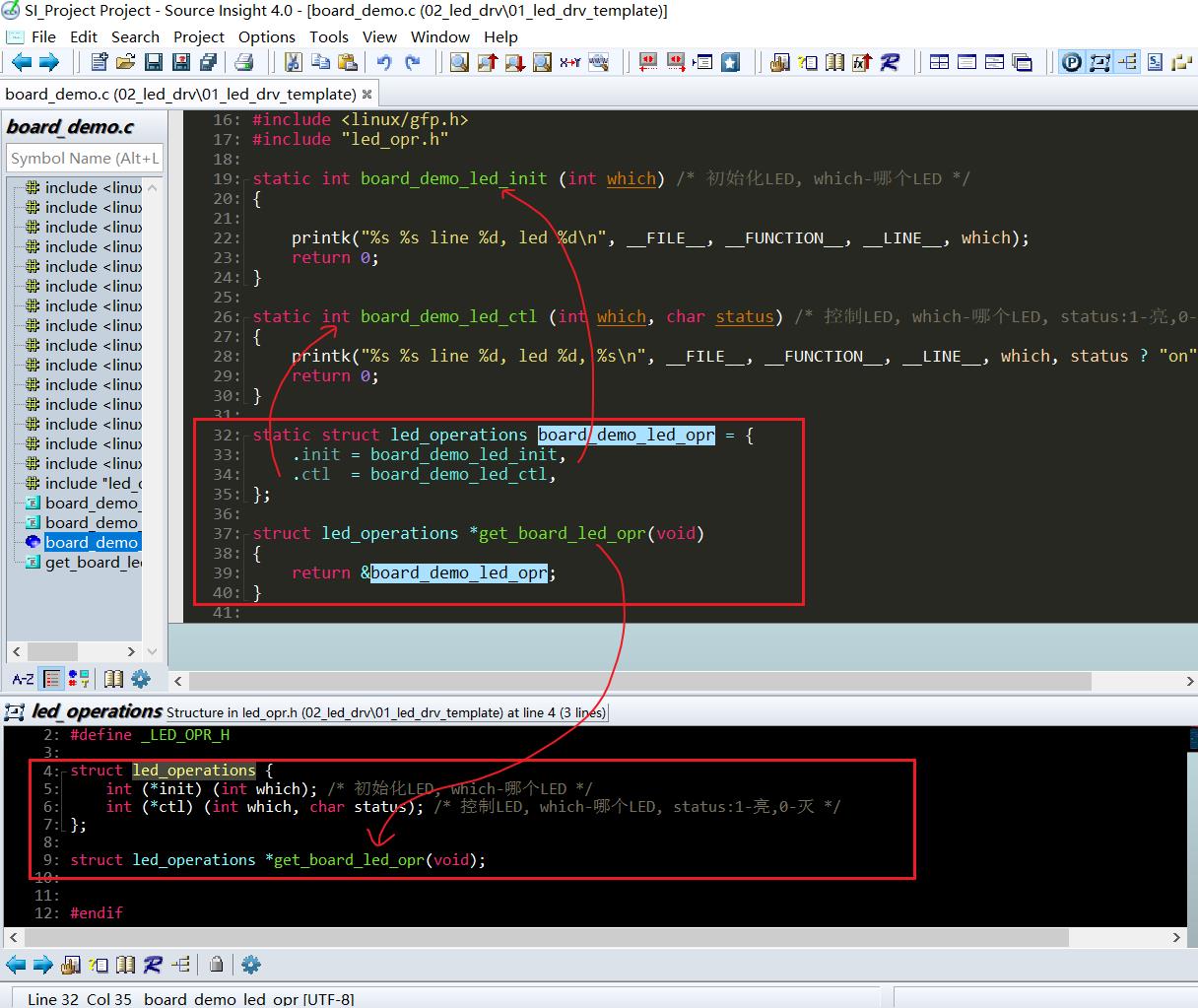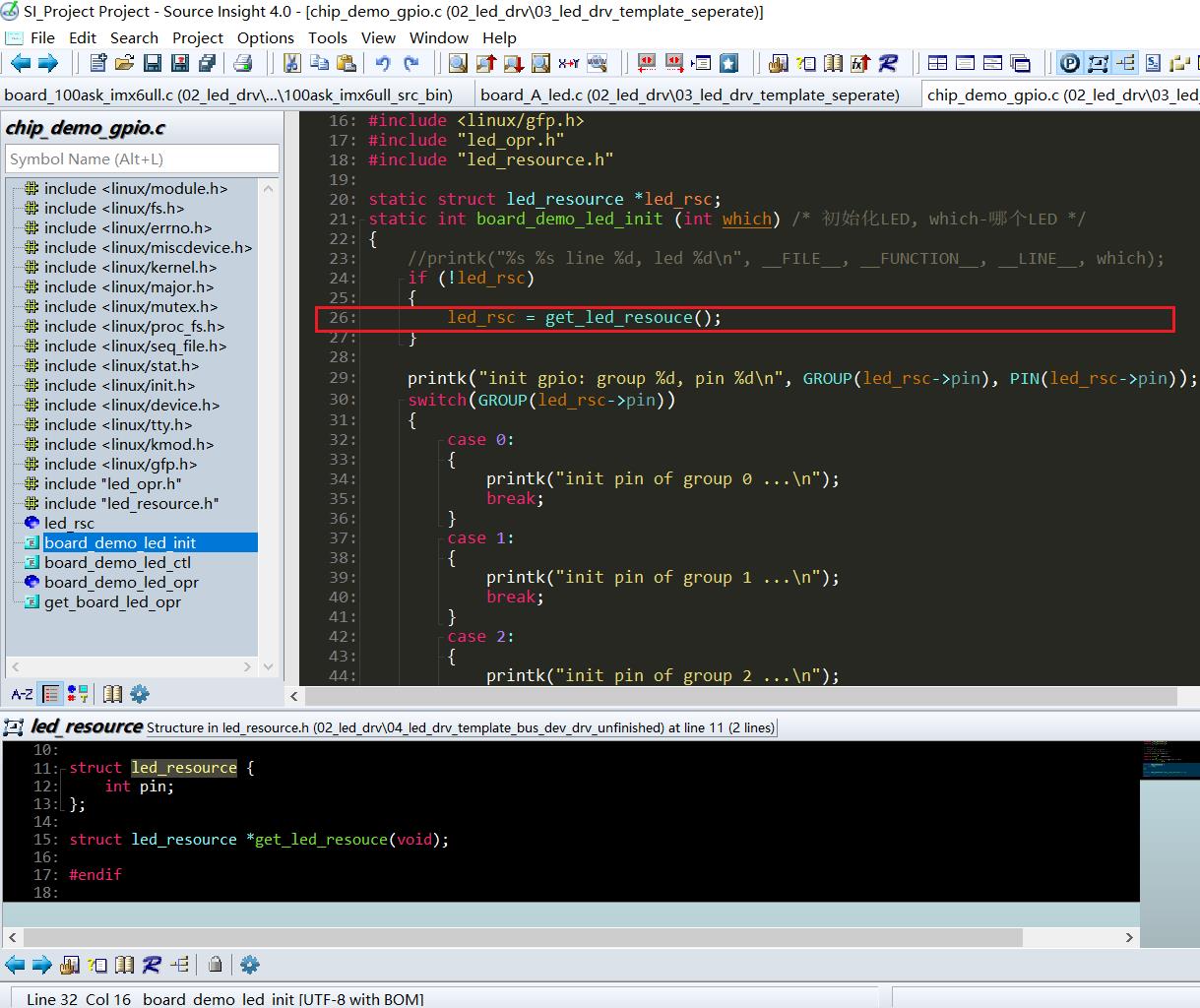正点原子I.MX6U-MINI驱动篇5 LED驱动程序框架:从分层到分离(非常重要)
Posted 果果小师弟
tags:
篇首语:本文由小常识网(cha138.com)小编为大家整理,主要介绍了正点原子I.MX6U-MINI驱动篇5 LED驱动程序框架:从分层到分离(非常重要)相关的知识,希望对你有一定的参考价值。
一、字符设备驱动程序框架

图中驱动层访问硬件外设寄存器依靠的是ioremap函数去映射到寄存器地址,然后开始控制寄存器。那么该如何编写驱动程序?
- 确定主设备号,也可以让内核分配;
- 定义自己的
fle_operations结构体,这是核心; - 实现对应的
drv_open/drv_read/drv_write等函数,填入file_operations结构体: - 把
file_operations结构体告诉内核:通过register_chrdev函数; - 谁来注册驱动程序?需要一个入口函数:安装驱动程序时,就会去调用这个入口函数:
- 有入口函数就应该有出口函数:卸载驱动程序是,出口函数调用
unregister chrdev; - 其它完善:提供设备信息,自动创建设备节点:
class create,device create;
二、分层思想(上下驱动和硬件分层)

把驱动拆分为通用的框架(leddrv.c)、具体的硬件操作(board_X.c):

以面向对象的思想,改进代码,抽象出一个结构体:

在单板文件中初始化这个结构体
#include <linux/module.h>
#include <linux/fs.h>
#include <linux/errno.h>
#include <linux/miscdevice.h>
#include <linux/kernel.h>
#include <linux/major.h>
#include <linux/mutex.h>
#include <linux/proc_fs.h>
#include <linux/seq_file.h>
#include <linux/stat.h>
#include <linux/init.h>
#include <linux/device.h>
#include <linux/tty.h>
#include <linux/kmod.h>
#include <linux/gfp.h>
#include "led_opr.h"
static int board_demo_led_init (int which) /* 初始化LED, which-哪个LED */
printk("%s %s line %d, led %d\\n", __FILE__, __FUNCTION__, __LINE__, which);
return 0;
static int board_demo_led_ctl (int which, char status) /* 控制LED, which-哪个LED, status:1-亮,0-灭 */
printk("%s %s line %d, led %d, %s\\n", __FILE__, __FUNCTION__, __LINE__, which, status ? "on" : "off");
return 0;
static struct led_operations board_demo_led_opr =
.init = board_demo_led_init,
.ctl = board_demo_led_ctl,
;
struct led_operations *get_board_led_opr(void)
return &board_demo_led_opr;

每个单板相关的board_X.c实现自己的led_operations结构体,供上层的leddrv.c调用:

2.1、编写代码
2.1.1 驱动程序
驱动程序分为上下两层:leddrv.c、board_demo.c。leddrv.c负责注册file_operations结构体,它的open/write成员会调用board_demo.c中提供的硬件led_opr中的对应函数。
1、把LED的操作抽象出一个led_operations结构体首先看看led_opr.h,它定义了一个led_operations结构体,把LED的操作抽象为这个结构体:
#ifndef _LED_OPR_H
#define _LED_OPR_H
struct led_operations
int (*init) (int which); /* 初始化LED, which-哪个LED */
int (*ctl) (int which, char status); /* 控制LED, which-哪个LED, status:1-亮,0-灭 */
;
struct led_operations *get_board_led_opr(void);
#endif

2、驱动程序的上层:file_operations结构体上层是leddrv.c,它的核心是file_operations结构体,首先看看入口函数:
#include <linux/module.h>
#include <linux/fs.h>
#include <linux/errno.h>
#include <linux/miscdevice.h>
#include <linux/kernel.h>
#include <linux/major.h>
#include <linux/mutex.h>
#include <linux/proc_fs.h>
#include <linux/seq_file.h>
#include <linux/stat.h>
#include <linux/init.h>
#include <linux/device.h>
#include <linux/tty.h>
#include <linux/kmod.h>
#include <linux/gfp.h>
#include "led_opr.h"
#define LED_NUM 2
/* 1. 确定主设备号 */
static int major = 0;
static struct class *led_class;
struct led_operations *p_led_opr;
#define MIN(a, b) (a < b ? a : b)
/* 3. 实现对应的open/read/write等函数,填入file_operations结构体 */
static ssize_t led_drv_read (struct file *file, char __user *buf, size_t size, loff_t *offset)
printk("%s %s line %d\\n", __FILE__, __FUNCTION__, __LINE__);
return 0;
/* write(fd, &val, 1); */
static ssize_t led_drv_write (struct file *file, const char __user *buf, size_t size, loff_t *offset)
int err;
char status;
struct inode *inode = file_inode(file);
int minor = iminor(inode);
printk("%s %s line %d\\n", __FILE__, __FUNCTION__, __LINE__);
err = copy_from_user(&status, buf, 1);
/* 根据次设备号和status控制LED */
p_led_opr->ctl(minor, status);
return 1;
static int led_drv_open (struct inode *node, struct file *file)
int minor = iminor(node);
printk("%s %s line %d\\n", __FILE__, __FUNCTION__, __LINE__);
/* 根据次设备号初始化LED */
p_led_opr->init(minor);
return 0;
static int led_drv_close (struct inode *node, struct file *file)
printk("%s %s line %d\\n", __FILE__, __FUNCTION__, __LINE__);
return 0;
/* 2. 定义自己的file_operations结构体 */
static struct file_operations led_drv =
.owner = THIS_MODULE,
.open = led_drv_open,
.read = led_drv_read,
.write = led_drv_write,
.release = led_drv_close,
;
/* 4. 把file_operations结构体告诉内核:注册驱动程序 */
/* 5. 谁来注册驱动程序啊?得有一个入口函数:安装驱动程序时,就会去调用这个入口函数 */
static int __init led_init(void)
int err;
int i;
printk("%s %s line %d\\n", __FILE__, __FUNCTION__, __LINE__);
major = register_chrdev(0, "100ask_led", &led_drv); /* /dev/led */
led_class = class_create(THIS_MODULE, "100ask_led_class");
err = PTR_ERR(led_class);
if (IS_ERR(led_class))
printk("%s %s line %d\\n", __FILE__, __FUNCTION__, __LINE__);
unregister_chrdev(major, "100ask_led");
return -1;
for (i = 0; i < LED_NUM; i++)
device_create(led_class, NULL, MKDEV(major, i), NULL, "100ask_led%d", i); /* /dev/100ask_led0,1,... */
p_led_opr = get_board_led_opr();
return 0;
/* 6. 有入口函数就应该有出口函数:卸载驱动程序时,就会去调用这个出口函数 */
static void __exit led_exit(void)
int i;
printk("%s %s line %d\\n", __FILE__, __FUNCTION__, __LINE__);
for (i = 0; i < LED_NUM; i++)
device_destroy(led_class, MKDEV(major, i)); /* /dev/100ask_led0,1,... */
device_destroy(led_class, MKDEV(major, 0));
class_destroy(led_class);
unregister_chrdev(major, "100ask_led");
/* 7. 其他完善:提供设备信息,自动创建设备节点 */
module_init(led_init);
module_exit(led_exit);
MODULE_LICENSE("GPL");

其中第102行
p_led_opr = get_board_led_opr();
从底层硬件相关的代码board_demo.c中获得led_operaions结构体。
2.1.2 测试程序编写
测试程序为ledtest.c:
#include <sys/types.h>
#include <sys/stat.h>
#include <fcntl.h>
#include <unistd.h>
#include <stdio.h>
#include <string.h>
/*
* ./ledtest /dev/100ask_led0 on
* ./ledtest /dev/100ask_led0 off
*/
int main(int argc, char **argv)
int fd;
char status;
/* 1. 判断参数 */
if (argc != 3)
printf("Usage: %s <dev> <on | off>\\n", argv[0]);
return -1;
/* 2. 打开文件 */
fd = open(argv[1], O_RDWR);
if (fd == -1)
printf("can not open file %s\\n", argv[1]);
return -1;
/* 3. 写文件 */
if (0 == strcmp(argv[2], "on"))
status = 1;
write(fd, &status, 1);
else
status = 0;
write(fd, &status, 1);
close(fd);
return 0;
2.1.3 Makefile编写
KERN_DIR = /home/zhiguoxin/linux/IMX6ULL/linux-imx-rel_imx_4.1.15_2.1.0_ga_alientek
CURRENT_PATH := $(shell pwd)
all:
$(MAKE) -C $(KERN_DIR) M=$(CURRENT_PATH) modules
arm-linux-gnueabihf-gcc -o ledtest ledtest.c
clean:
$(MAKE) -C $(KERN_DIR) M=$(CURRENT_PATH) modules clean
rm -rf modules.order
rm -f ledtest
led_drv-y := leddrv.o board_demo.o
obj-m += led_drv.o
- 第1行,KERNELDIR表示Linux内核源码目录,使用绝对路径,大家根据自己的实际情况填写。这种方式适用于嵌入式开发的交叉编译,KERN_DIR目录中包含了内核驱动模块所需要的各种头文件及依赖。
- 第2行,CURRENT_PATH表示当前路径,直接通过运行pwd命令来获取当前所处路径。
- 第5行,具体的编译命令,后面的modules表示编译模块,
-C表示将当前的工作目录切换到指定目录中,也就是KERNERLDIR目录执行makefile。M表示模块源码目录,make modules命令中加入M=dir以后程序会自动到指定的dir目录中读取模块的源码并将其编译为.ko文件。 - 第6行,使用交叉编译工具链将ledtest.c编译成可以在arm板子上运行的ledtest可执行文件。
- 第9行,清除modules。
- 第10行,清除modules.order。
- 第11行,清除ledtest。
- 第13、14行,要想把leddrv.c,board_demo.c编译成led_drv.ko。
2.1.4 源码目录

2.2、具体单板的LED驱动程序
上面的board_demo.c文件中的board_demo_led_init和board_demo_led_ctl函数并没有实现

我现在使用的是im6ull板子,我现在就只需要在里面添加相应的操作即可,这样我们的驱动文件就不需要做任何的修改
#include <linux/module.h>
#include <linux/fs.h>
#include <linux/errno.h>
#include <linux/miscdevice.h>
#include <linux/kernel.h>
#include <linux/major.h>
#include <linux/mutex.h>
#include <linux/proc_fs.h>
#include <linux/seq_file.h>
#include <linux/stat.h>
#include <linux/init.h>
#include <linux/device.h>
#include <linux/tty.h>
#include <linux/kmod.h>
#include <linux/gfp.h>
#include <asm/io.h>
#include "led_opr.h"
static volatile unsigned int *CCM_CCGR1 ;
static volatile unsigned int *IOMUXC_SNVS_SW_MUX_CTL_PAD_SNVS_TAMPER3;
static volatile unsigned int *GPIO5_GDIR ;
static volatile unsigned int *GPIO5_DR ;
static int board_demo_led_init (int which) /* 初始化LED, which-哪个LED */
unsigned int val;
//printk("%s %s line %d, led %d\\n", __FILE__, __FUNCTION__, __LINE__, which);
if (which == 0)
if (!CCM_CCGR1)
CCM_CCGR1 = ioremap(0x20C406C, 4);
IOMUXC_SNVS_SW_MUX_CTL_PAD_SNVS_TAMPER3 = ioremap(0x2290014, 4);
GPIO5_GDIR = ioremap(0x020AC000 + 0x4, 4);
GPIO5_DR = ioremap(0x020AC000 + 0, 4);
/* GPIO5_IO03 */
/* a. 使能GPIO5
* set CCM to enable GPIO5
* CCM_CCGR1[CG15] 0x20C406C
* bit[31:30] = 0b11
*/
*CCM_CCGR1 |= (3<<30);
/* b. 设置GPIO5_IO03用于GPIO
* set IOMUXC_SNVS_SW_MUX_CTL_PAD_SNVS_TAMPER3
* to configure GPIO5_IO03 as GPIO
* IOMUXC_SNVS_SW_MUX_CTL_PAD_SNVS_TAMPER3 0x2290014
* bit[3:0] = 0b0101 alt5
*/
val = *IOMUXC_SNVS_SW_MUX_CTL_PAD_SNVS_TAMPER3;
val &= ~(0xf);
val |= (5);
*IOMUXC_SNVS_SW_MUX_CTL_PAD_SNVS_TAMPER3 = val;
/* b. 设置GPIO5_IO03作为output引脚
* set GPIO5_GDIR to configure GPIO5_IO03 as output
* GPIO5_GDIR 0x020AC000 + 0x4
* bit[3] = 0b1
*/
*GPIO5_GDIR |= (1<<3);
return 0;
static int board_demo_led_ctl (int which, char status) /* 控制LED, which-哪个LED, status:1-亮,0-灭 */
//printk("%s %s line %d, led %d, %s\\n", __FILE__, __FUNCTION__, __LINE__, which, status ? "on" : "off");
if (which == 0)
if (status) /* on: output 0*/
/* d. 设置GPIO5_DR输出低电平
* set GPIO5_DR to configure GPIO5_IO03 output 0
* GPIO5_DR 0x020AC000 + 0
* bit[3] = 0b0
*/
*GPIO5_DR &= ~(1<<3);
else /* off: output 1*/
/* e. 设置GPIO5_IO3输出高电平
* set GPIO5_DR to configure GPIO5_IO03 output 1
* GPIO5_DR 0x020AC000 + 0
* bit[3] = 0b1
*/
*GPIO5_DR |= (1<<3);
return 0;
static struct led_operations board_demo_led_opr =
.num = 1,
.init = board_demo_led_init,
.ctl = board_demo_led_ctl,
;
struct led_operations *get_board_led_opr(void)
return &board_demo_led_opr;

三、分离思想(上中下三层)
3.1 面向对象
字符设备驱动程序抽象出一个file_operations结构体;我们写的程序针对硬件部分抽象出led_operations结构体。
3.2 驱动分层
上下分层,比如我们前面第二节写的LED驱动程序就分为2层:
- 1.上层实现硬件无关的操作,比如注册字符设备驱动:leddrv.c
- 2.下层实现硬件相关的操作,比如board A.c实现单板A的LED操作

3.3 驱动分离
还能不能改进?分离。
在board A.c中,实现了一个led operations,为LED引脚实现了初始化函数、控制函数:
static struct led_operations board_demo_led_opr =
.num = 1,
.init = board_demo_led_init,
.ctl = board_demo_led_ctl,
;
如果硬件上更换一个引脚来控制LED怎么办?你要去修改上面结构体中的init、ctl函数。

实际情况是,每一款芯片它的GPI0操作都是类似的。比如:GPIO1_3、GPIO5_4这2个引脚接到LED:
-
GPIO1_3属于第1组,即GPIO1
- 有方向寄存器DIR、数据寄存器DR等,基础地址是
addr base addr gpio1。 - 设置为output引脚:修改GPIO1的DIR寄存器的
bit3。 - 设置输出电平:修改GPIO1的DR寄存器的
bit3。
- 有方向寄存器DIR、数据寄存器DR等,基础地址是
-
GPIO5_4属于第5组,即GPIO5
- 有方向寄存器DIR、数据寄存器DR等,基础地址是
addr base addr gpio5。 - 设置为output引脚:修改GPIO5的DIR寄存器的
bit4。 - 设置输出电平:修改GPIO5的DR寄存器的bit4。
- 有方向寄存器DIR、数据寄存器DR等,基础地址是
既然引脚操作那么有规律,并且这是跟主芯片相关的,那可以针对该芯片写出比较通用的硬件操作代码。
比如board A.c使用芯片chipY,那就可以写出:chipY_gpio.c,它实现芯片Y的GPIO操作,适用于芯片Y的所有GPIO引脚。
使用时,我们只需要在board_A_led.c中指定使用哪一个引脚即可。程序结构如下:


以面向对象的思想,在board_A_led.c中实现led resouce结构体,它定义“资源”一要用哪一个引脚。
在chipY_gpio.c中仍是实现led_operations结构体,它要写得更完善,支持所有GPIO。
3.3、编写代码
3.3.1 驱动程序
程序仍分为上下结构:上层leddrv.c向内核注册file operations结构体;下层chip_demo_gpio.c提供led_operations结构体来操作硬件。
下层的代码分为2个:chip_demo_gpio.c实现通用的GPI0操作,board A led.c指定使用哪个GPIO,即“资源”。
led_resource.h中定义了led_resource结构体,用来描述GPIO:

board_A_led.c 指定使用哪个GPIO,它实现一个led_resource结构体,
并提供访问函数:

chip_demo_gpio.c中,首先获得board_A_led.c实现的led_resource结构体,然后再进行其他操作,请看下面第 26 行:

3.3.2 chip_demo_gpio.c
#include <linux/gfp.h>
#include "led_opr.h"
#include "led_resource.h"
static struct led_resource *led_rsc;
static int board_demo_led_init (int which) /* 初始化LED, which-哪个LED */
//printk("%s %s line %d, led %d\\n", __FILE__, __FUNCTION__, __LINE__, which);
if (!led_rsc)
led_rsc = get_led_resouce();
printk("init gpio: group %d, pin %d\\n"